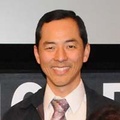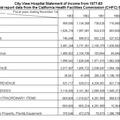INTRODUCTION
In the waning days of July, 1985, City View Hospital was transferring its last few patients to St. Vincent’s Medical Center across town. The administrator and the board decided to close the hospital after many months of financial losses, seeking to conserve the remaining assets. They attributed City View’s demise as a result of DRG’s (Diagnosis Related Groups) and the economic hardship which DRG’s created.
No doubt this scene occurred often across the nation in the wake of the first set of DRG’s. What was unique to this particular story was that City View Hospital represented the last of its species; it was the last known functioning Japanese-American hospital in the United States, an institution raised by the community in response to past injustices.
During the final months of City View’s existence, its fiscal troubles sparked a lively debate carried on in the vernacular Japanese newspapers in Los Angeles. Did the large Japanese-American community in Los Angeles still require the services of a hospital of its own Or could its needs be met through other means, such as a special ward of a larger hospital? What specific groups within the Japanese-American community desired to continue the institution of a hospital? Why was the present hospital in crisis? In the event of closure of the present hospital, what alternatives existed to continue health care to this community?
In the midst of this turmoil over the uncertain future of this last Japanese-American hospital I began my study. City View Hospital was heir to a tradition of service spanning seventy years. Its process of growth, maturity and decay reflected many changes within its target community, and the roots of its present crisis become more distinct in this context. The impact of the reduction in reimbursement brought on by the DRG’s was perhaps more profound due to certain demographic trends in the hospital’s medical staff and patient population. So this study shall first trace the historical origins of Japanese-American hospitals, focusing on this particular hospital.
It became clear during the study that hospitals themselves have undergone dramatic transformations in tandem with their respective communities. The environment of medicine in which both physicians and hospitals function is, to say the least, changing rapidly. As medical technology increases, so too does the need for capital to finance the new instruments. As the number of physicians in the cities increases, so too does the competition for patients. As the technology develops and the number of specialists grows, the standard of care is pushed to higher levels. Finally, the federal government is continuing to modify its methods of payment for health care.
I wanted to see how this hospital responded to/adapted to/ coped with/ignored these changes. Since this was a small nonprofit community derived hospital, I wanted to analyze the success/failure of its adaptations in order to understand the strengths/weaknesses of its size and organization, to serve as a model of an ethnically oriented hospital in crisis.
Even though City View Hospital did close down its acute general medical/surgical services on July 31, 1985, this is not the end of its story. Back in the sixties, City View carried out a health needs assessment of the elderly first generation (Issei) Japanese-Americans and identified a need for retirement homes and nursing homes. The community wholeheartedly supported this plan and in less than twenty years three nursing homes, an Intermediate Care Facility, and retirement home were established. These thriving off-shoots of City View Hospital constitute a health care system known as Umbrella of Care. I want to touch on how these facilities operate and show what unique services they offer to the Japanese-American community throughout the United States.
Nor has City View Hospital’s story yet concluded. The medical staff signed an agreement with the nearby St. Vincent’s Medical Center and is “temporarily” using a wing of the hospital as a special Japanese-language ward. The staff eventually plans to start a new hospital. We will look at this is more depth. Also featured is Community Hospital of Gardena, a de facto Japanese hospital.
The phenomenon of an ethnic hospital is not confined to the Japanese. The most prominent example of an ethnic hospital are the Jewish hospitals. There are also French and Chinese hospitals. We will briefly outline their similarities and differences.
I have learned much about this particular Japanese-American community and the role of hospitals within it. I have learned in brief about other ethnic hospitals. I hope that the findings of this brief review might be useful to other ethnic communities in need of health care.
HISTORICAL BACKGROUND
This study will tell the story of the Japanese-American hospitals in California, as far as became known to me is the course of my fellowship. The emphasis will be on the physicians, both immigrant and American-born, who were responding to the opportunities and needs in health care in their own Japanese-American community. To commence this narrative we must take a brief look at the formation of the community through immigration.
Roger Daniels in his book The Politics of Prejudice has divided up the flow of immigration from Japan into five periods.1
1. 1861-1890: Unrestricted and scattered 3,000
2. 1891-1900: Unrestricted and growing 27,000
3. 1901-1908: Peak, unrestricted immigration 127,000
4. 1909-1924: Gentleman’s agreement in effect 118,000
5. 1925-1952: Exclusion, no immigration ----
Grand Total 275,000
However, since some made more than one trip, died, or moved elsewhere this figure is misleadingly high. Therefore, Daniels cites census figures for Japanese immigrants and native-born:
United States California
1880 148 86
1890 2,039 1,147
1900 24,326 10,151
1910 72,157 41,356
1920 111,010 71,952
1930 138,834 97,456
As one can see from the chart, from 1900 onwards there was a sizeable population of immigrants to generate demand for a Japanese physician. And after the Japanese immigrants married, a demand for midwives also arose.
According to Shin Hasegawa’s study2 “Exodus from Japan: Dr. Tashiro of Los Angeles,” the first medical knowledge in Japan followed after the Chinese model, later displaced by Dutch-based learning emanating from Nagasaki. During the time of the Meiji restoration, an English physician, William Williams, aided the Japanese Imperial troops. Through his contacts and influence, English medical knowledge began to spread throughout Japan.
The previously Dutch trained physicians resisted the transition of medical knowledge to an English-based system. In 1869, the official medical information coordinators of Japan began to stress German-based medical knowledge, both because the German language was similar to Dutch and because Germany had a high standard of medical excellence on par with England or France.
By 1870 the first thirteen people were dispatched as representatives of Japan’s medical field for study in Europe. In the following year, Leopold Muller came to Tokyo Imperial University and began to shape Japan’s medical system along the lines of the Prussian system.
Transcripts included in the applications of Japanese immigrants for physicians or midwives licenses show that many medical schools were functioning by the beginning of the twentieth century in Japan. Most of the physicians were licensed as such in Japan and had completed a year of internship in Japanese hospitals. Some served in the Imperial Army Hospitals during the Russo-Japanese war.
Notes:
1. Roger Daniels, The Politics of Prejudice: The Anti-Japanese Movement in California and the Struggle for Japanese Exclusion (University of California Press, 1962), p. 1.
2. Shin Hasegawa, Exodus from Japan: Dr. Tashiro of Los Angeles (Tokyo: Seiji-sha, 1978).
© 1986 Troy Tashiro Kaji




